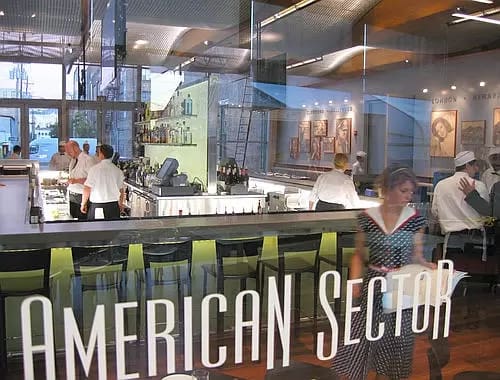Chef Besh is a hugely well known name on the US culinary scene and originates from the Deep South and is, understandably, wedded to N’Awlins. We ate regularly at one of his restaurants, The American Sector, whilst working in New Orleans. The two seats in the middle at the bar? Our station, man.

Here, in an Epicurious article from 2012, he writes on the Mangalitsa and how and why he and his chefs are now using it in their restaurants.
“I’m certainly not new to pork, as I grew up in a South Louisiana enclave where I had no recollection of early childhood vegetables that weren’t cooked in pork fat, or vegetables that didn’t at least taste like smokey bacon.
Grandmother kept an old French Market Coffee tin on the stove, which served as the go-to fat for just about all her cooking needs. I, like her, just simply add the morning’s rendered bacon drippings to the can and consequently, when the need arises to whip up a batch of red beans and rice (or anything else for that matter), I reach for the most flavorful fat in the house.
Surprisingly enough, being that I came from a place with a connection to its pork — through bacon, tasso, ham, andouille, chaurice, pigs ears, pickled pigs lips, jowls, and tails — we knew very little about the actual breeds we ate. It wasn’t until they ruined our pork that we even began to take notice.
The pig of my youth meant a celebration, a cochon de lait. Some of my favorite childhood food memories surround the slaughter and cooking of the suckling pig for holidays, christenings, or football championships.
Yet, during the decades that separate my childhood and now, the pig became demonized. Pig was bad, and pork was even worse.We Americans cast aside our pigs of old in an effort to create the healthy pig, the “other white meat” pig. And whatever breeding couldn’t produce, we figured out a way to produce what we wanted in factories. Diets of protein pellets and no space to move produced the other white meat, that ultimately became even unhealthier due to the types of fat produced by these sedentary beasts.
During these bad pig years in America, I traveled away to make a formal apprenticeship in the mountainous town of the Hochschwarzwald near the Swiss border. It was my time spent at the Romantik Hotel Spielweg that reintroduced me to pigs–good pigs. Pigs that were fed a good diet, and pigs that were kept in pristine conditions, and consequently, pigs that produced good fat and an abundance of it. These pigs looked different and acted different. They had style! They were long-haired with personality, quite friendly! These were the types of pigs you’d want to associate with. These were the ancient breed known as Wollschwein. Each apprentice carried the responsibility of caring for the pigs: feeding, cleaning and tidying up the spacious “pig pens.” It was all part of the day’s work. Each month, a pig would be harvested and transformed into luscious bacon, hams, blood sausages, liver sausages, head cheese, and everything else that your taste buds could revel in. Not only did the pigs give us all this charcuterie but it also gave us the most lovely family-meals ever.
As years would pass, the status of the American swine would rise again, this time to the point of deity for the millennial generation. They had never known the pig or religion, or at least not the real ones, and this is cause for celebration for them. So much so that this generation now tattoos pigs, pig parts, pig products, and pig names on themselves in an unprecedented fashion, as if a new animal had been discovered. They show off the latest artist’s rendering of a heritage breed hog across their upper buttocks, lower forearm, hairy leg or hairless chest. Good pigs are now found everywhere! Everywhere besides where’d you expect them: the store.
We began raising Berkshire hogs several years ago, feeding them spent barley left over from our brewing program, along with a supplemented diet of green vegetable trimmings that we acquired in each kitchen, as we did in Germany. This produced some of the finest pork I’ve ever had. For years, I had been content with my Berkshires, until Ashley and Dave Matthews told me about Heath Putnam who breeds woolly pigs (aka Mangalitsas). They had met him through the farmers market in Seattle.
The Matthews insisted I give the Mangalitsas a try, and try I did. Curious as to how they would adjust to our heat and humidity of South Louisiana, I began with just a dozen hogs. Not only did they adjust to their subtropical environment, but also thrived. A diet of milled black-eyed peas, barley, and rice bran, as well as the supplement feeding of various green trimmings and spent barley made the meat and the fat succulent and delicious.
All of what we raise ourselves is used, converting the hams into country ham and the bellies into bacon. The other parts are used for a combination of charcuterie and roasting meats. All said and done, nothing is spared, and all that it yields is then divided up and distributed among our restaurants. We don’t have the capability to produce all that we consume so we leave it up to Heath to do the rest. Selling us the off cuts and through Johnson County Country hams, we have Mangalitsa bacon and cured hams at our fingertips as we need them. I’m proud to continue the delicious traditions of my youth and pass on the teachings of my time in Germany right in my own farm and in our restaurants.”